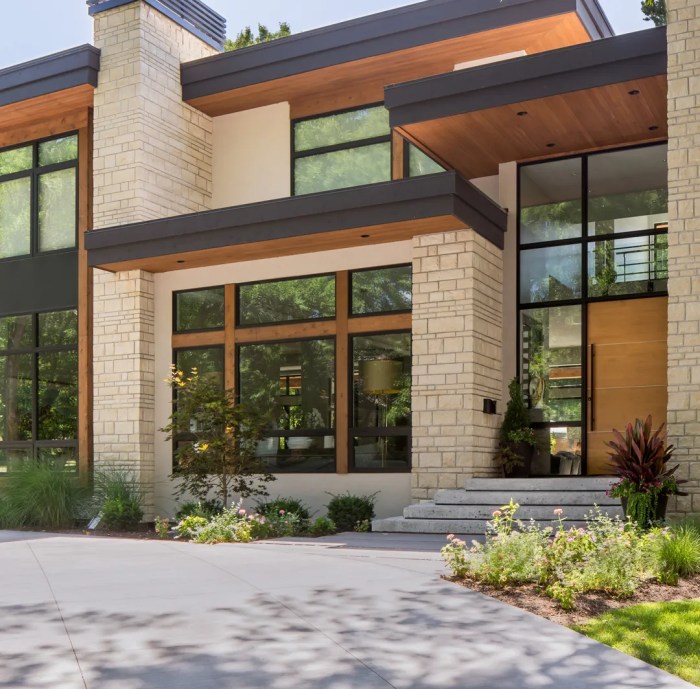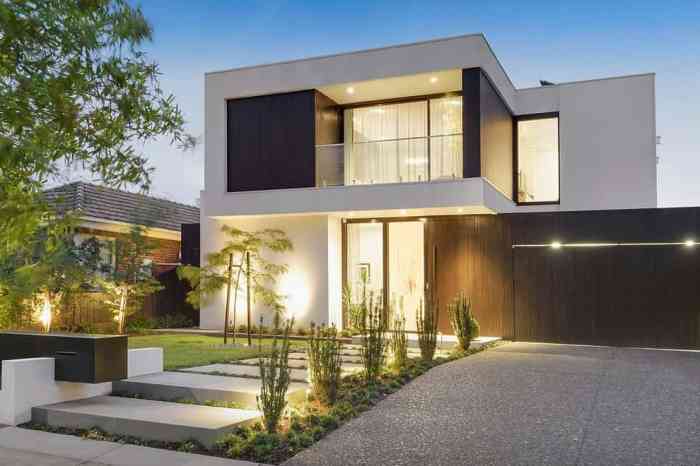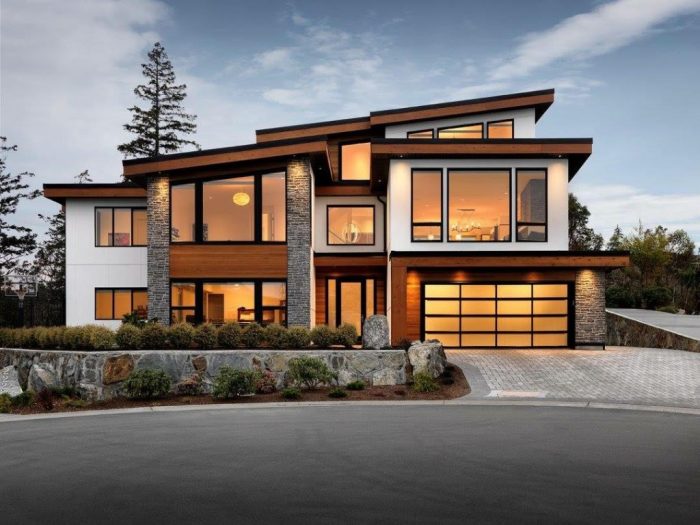Exploring Modern Exterior Designs: A Comprehensive Guide
Embark on a journey through the world of modern exterior designs, where innovation and style merge to create stunning architectural masterpieces. From sleek lines to captivating color schemes, this guide delves into the essence of modern exteriors, offering insights that will inspire both homeowners and designers alike.
Delve deeper into the elements that define modern exteriors and uncover the secrets behind their timeless appeal.
Definition of Modern Exterior
A modern exterior design in architecture is characterized by clean lines, minimal ornamentation, and a focus on functionality and simplicity. It often incorporates elements such as large windows, flat or sloped roofs, and a mix of materials to create a sleek and contemporary look.
Key Characteristics of Modern Exteriors
- Use of industrial materials such as concrete, steel, and glass
- Flat or shed roofs with clean lines
- Open floor plans and large windows for natural light
- Minimalist design with a focus on geometric shapes
- Integration of outdoor living spaces
Materials Used in Modern Exterior Design
- Concrete: Provides a sleek and modern look
- Steel: Adds a contemporary and industrial touch
- Glass: Enhances natural light and creates a seamless connection to the outdoors
- Wood: Adds warmth and texture to the design
Difference from Traditional or Contemporary Styles
Modern exteriors differ from traditional styles by their focus on function over form, use of industrial materials, and minimalist approach. In contrast to contemporary styles, modern exteriors tend to have a more timeless and enduring aesthetic, with a stronger emphasis on clean lines and simplicity.
Elements of Modern Exterior Design

In modern exterior design, various elements come together to create a sleek and contemporary look. Let's explore some key factors that contribute to the modern aesthetic.
Role of Lines and Shapes
Lines and shapes play a crucial role in modern exterior design by defining the overall structure and form of a building. Clean, straight lines are often used to create a sense of simplicity and sophistication. Angular shapes and geometric patterns can add visual interest and a sense of modernity to the exterior design.
Use of Textures and Finishes
Textures and finishes are essential in creating a modern look for exteriors. Smooth surfaces, such as glass or metal, are commonly used to achieve a sleek and minimalist appearance. Contrasting textures, like combining wood with concrete, can add depth and visual appeal to the design.
The choice of finishes, whether matte or glossy, can also impact the overall modern aesthetic.
Importance of Minimalism
Minimalism is a key principle in modern exterior design, emphasizing simplicity and functionality. Clutter-free spaces, clean lines, and a limited color palette are characteristic of minimalist design. By focusing on essential elements and eliminating excess decoration, modern exteriors exude a sense of elegance and sophistication.
Significance of Natural Light
Natural light plays a vital role in enhancing modern exteriors by creating a connection between the indoor and outdoor spaces. Large windows, glass walls, and skylights are often incorporated into modern designs to maximize natural light and create a bright, airy atmosphere.
The play of light and shadow further accentuates the architectural features, adding depth and visual interest to the exterior design.
Color Schemes in Modern Exterior
When it comes to modern exterior design, color plays a crucial role in creating a visually appealing and cohesive look for a building. The choice of color scheme can greatly impact the overall aesthetic and style of a modern exterior.
Popular Color Palettes
In modern exterior design, popular color palettes often include a mix of neutral tones such as whites, grays, and blacks, along with bold accent colors like navy blue, deep green, or even vibrant red. These combinations create a striking contrast that adds visual interest and depth to the facade.
Impact of Color Choices
The color choices in modern exteriors can significantly influence the mood and feel of a building. Lighter hues can make a structure appear more open and airy, while darker shades can create a sense of sophistication and drama. The right color palette can enhance architectural details and highlight design elements.
Contrasting Colors
Contrasting colors are often used in modern exterior design to create a dynamic and eye-catching look. Pairing light and dark shades, or combining complementary colors, can help emphasize different parts of the building and create a sense of balance. Bold contrasts can make a modern exterior stand out and make a statement
Role of Neutrals
Neutrals play a crucial role in modern exterior color schemes by providing a clean and timeless backdrop for other colors to pop. Whites, grays, and beiges are commonly used as primary colors in modern exteriors, allowing for flexibility in adding pops of color through accents like doors, window frames, or trim.
Neutrals also help unify different elements of the exterior design and create a cohesive look.
Landscaping and Outdoor Spaces

Landscaping plays a crucial role in enhancing the overall aesthetic appeal of modern exterior design. It not only complements the architectural style but also adds a touch of natural beauty to the outdoor spaces.
Integration of Landscaping in Modern Exterior Design
Modern exterior design often incorporates landscaping elements such as carefully curated plantings, green walls, and sustainable features like rain gardens. These elements not only soften the hard lines of modern architecture but also help create a harmonious balance between the built environment and nature.
Principles of Landscaping in Modern Architecture
Minimalism
Clean lines, simple plantings, and a focus on functionality are key principles of landscaping in modern architecture.
Sustainability
Using native plants, water-efficient irrigation systems, and environmentally friendly materials are essential in modern landscaping practices.
Integration
The landscaping should seamlessly blend with the architectural design, creating a cohesive and visually appealing outdoor space.
Seamless Design of Outdoor Spaces
Outdoor spaces in modern exteriors are designed to flow seamlessly from the interior, blurring the lines between indoor and outdoor living. This design approach often includes features like outdoor kitchens, dining areas, lounges, and fire pits, creating functional and inviting spaces for relaxation and entertainment.
Sustainable Landscaping Practices in Modern Exterior Designs
Xeriscaping
Using drought-tolerant plants and efficient irrigation systems to reduce water consumption.
Permeable Paving
Installing permeable surfaces like gravel or pavers to allow rainwater to infiltrate the ground, reducing runoff.
Green Roofs
Incorporating living roofs with vegetation to improve insulation, reduce energy costs, and mitigate stormwater runoff.
Last Word

In conclusion, modern exterior designs redefine the boundaries of architectural aesthetics, blending functionality with beauty in perfect harmony. Embrace the allure of modernity and elevate your living space with the transformative power of contemporary design.
Answers to Common Questions
What defines a modern exterior design?
A modern exterior design is characterized by clean lines, minimalistic features, and a focus on functionality over ornamentation.
How does natural light play a role in modern exteriors?
Natural light is a crucial element in modern exteriors as it enhances the overall ambiance, creates a sense of spaciousness, and promotes energy efficiency.
What are some popular color palettes used in modern exterior design?
Popular color palettes include monochromatic schemes, bold contrasts, and muted neutrals that emphasize the architectural elements of the design.
How is landscaping integrated into modern exterior design?
Landscaping in modern exteriors is carefully planned to complement the architectural style, incorporating sustainable practices and creating a harmonious outdoor space.




